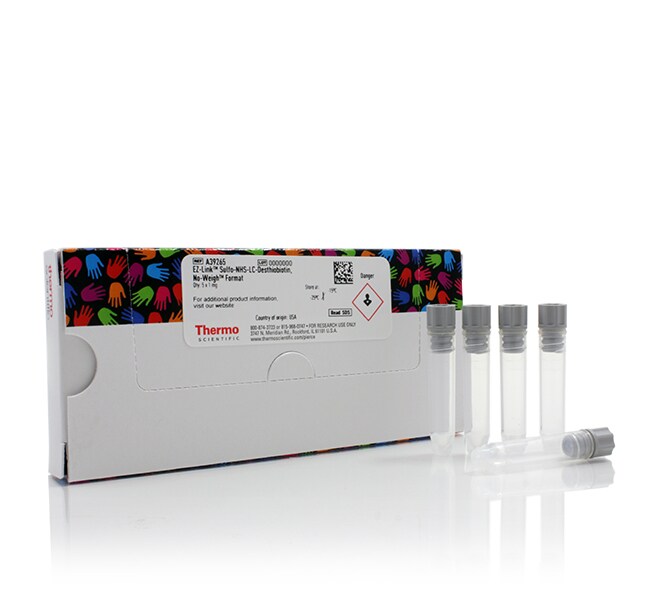
Thermo Scientific EZ-Link Sulfo-NHS-LC-Desthiobiotin is a long-chain, amine-reactive labeling reagent whose biotin-like group is elutable from streptavidin, making it ideal for purified or cell surface protein labeling and purification.
Features of EZ-Link Sulfo-NHS-LC-Desthiobiotin:
• Desthiobiotin—analog of biotin allows easy elution from streptavidin, an ideal feature for affinity purification applications
• Protein labeling—tag antibodies or proteins in purified or mixed samples to enable high recovery in pull-down assays with streptavidin beads
• Cell surface labeling—modifies only surface proteins of whole cells because the negatively charged reagent does not permeate cell membranes
• Amine-reactive—reacts with primary amines (-NH2), such as lysine side-chains, or the amino-termini of polypeptides
• Soluble—charged sulfo-NHS group increases reagent water solubility compared to ordinary NHS-ester compounds
Sulfo-NHS-LC-Desthiobiotin is a variant of biotin that is activated as a sulfo-NHS ester with a long-chain (LC) spacer arm to covalently label primary amines (-NH2) of proteins or other molecules with desthiobiotin groups. The desthiobiotin tag binds to streptavidin and other biotin-binding proteins with high specificity yet readily elutes with mild conditions (i.e., by competitive displacement with regular, free biotin). As such, this reagent is a useful alternative to Sulfo-NHS-LC-Biotin (Part No. 21335) for avidin-biotin techniques in which nondenaturing elution of the labeled proteins is desired. The negatively charged sulfo-NHS group prevents this reagent from permeating cell membranes; therefore, Sulfo-NHS-LC-Desthiobiotin can be used to confine labeling to cell surface proteins of intact cells. The No-Weigh Format (5 x 1 mg resealable vials) eliminates the difficulties associated with weighing small quantities of reagent and maximizes protection of unused reagent from hydrolysis.
Desthiobiotin vs. Biotin
Desthiobiotin is a single-ring, sulfur-free analog of biotin that binds to streptavidin with nearly equal specificity but less affinity than biotin (1/Kd = 1011 vs. 1015 M, respectively). Consequently, desthiobiotinylated bait proteins and their interacting partners can be eluted readily and specifically from streptavidin affinity resin using mild conditions based on competitive displacement with free biotin. For pull-down assay experiments with biological samples, this soft-release characteristic of desthiobiotin also helps to minimize co-purification of endogenous biotinylated molecules, which remain bound to streptavidin upon elution of the target protein complexes with free biotin. The modified avidin-biotin affinity system also eliminates the need to use harsh elution conditions that might disassociate complexes and/or damage the target protein or cell. Desthiobiotin-based techniques are ideal when using native or recombinant proteins that are not expressed with a fusion tag and when isolating captured proteins under native conditions, such as targeting intact cells or cell surface proteins.
Labeling with NHS Ester Reagents
N-Hydroxysulfosuccinimide (NHS) esters of biotin are the most popular type of biotinylation reagent. NHS-activated biotins react efficiently with primary amino groups (-NH2) in alkaline buffers to form stable amide bonds. Proteins typically have several primary amines that are available as targets for labeling, including the side chain of lysine (K) residues and the N-terminus of each polypeptide. Most sulfo-NHS esters are directly water soluble but not membrane permeable. Plain NHS esters are less soluble in aqueous buffers but are membrane permeable.
| Code | Description |
|---|---|
| A39265 | Catalog Number: A39265 |

